《教育公平》
- 格式:ppt
- 大小:780.00 KB
- 文档页数:29

熊丙奇教授:《教育公平:让教育回归本质》一、编辑推荐:教育,每一步都与个人息息相关,公平,你我必须关注1、熊丙奇对教育公平的深切关注。
杨东平鼎力推荐。
2、他用自己的思考告诉公众,争取公平的权益,与每一个普通人相关。
3、不抱怨,不责问,出于知识分子的良知,对教育困境给出可尝试的解决方案。
二、内容简介:每一个人都不是旁观者。
也许你可以无视打工子女在城市无法求学,因为那不是你的孩子。
也许你反对随迁子女在大城市高考,因为那会侵占你孩子的高考利益。
也许你也赞成把不听话有疾病的孩子赶出教室,因为这会影响聪明的孩子学习。
然而,在一个没有公平保障的社会中,每一个人都可能成为不公平的受害者。
熊丙奇教授本着一份对教育公平的关切之情,关注弱势群体的入学问题,关注教育资源的分配难题,关注学校在这个社会的多元定位问题。
这是一个公民对教育公平的呼唤,这是一个知识分子对目前教育困境的思考。
不抱怨,不责问,出于知识分子的良知,对教育困境给出可尝试的解决方案。
三、作者简介:熊丙奇,著名教育学者熊丙奇博士,21世纪教育研究院副院长、中国高校校报协会副会长、上海市高校校报研究会理事长。
熊丙奇博士主编、编著、著作的书有:《教育的挑战》《大学有问题》、《体制迷墙》、《天下无墙》、《教育熊视》等20种30余版次。
为《中国教育报》《新京报》、《北京青年报》、《南方都市报》等报专栏作者。
2009年被中国教育电视台、腾讯网联合评为“2009年度致敬之教育时评家”。
2011年获评网易“年度教育时评家”、央广十大教育改革杰出人物。
四、目录序第一部分抛荒被抛弃的村小——撤点并校被边缘的群体——留守与流动儿童被抛弃的教师——代课教师第二部分撕裂被资源撕裂——好学校、坏学校被分数撕裂——差生、优生被身份撕裂——富生、穷生被利益撕裂——本地人、外地人第三部分梦碎底层固化——新读书无用论大学梦碎——名校情结就业梦碎——父辈就业第四部分畸变分数至上——全盘应试城市思维——剥夺弱者权力通道——教育腐败第五部分出路均衡资源——打破利益链补偿公平——消除特权救济权利——依法治教多元发展——推进教改。
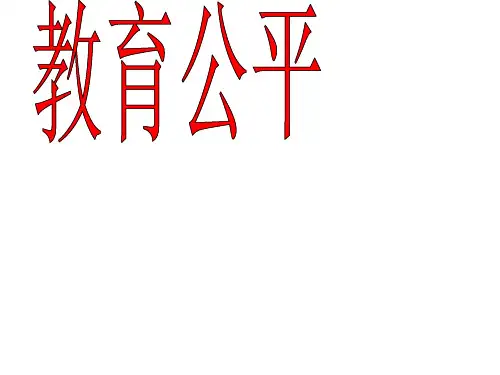
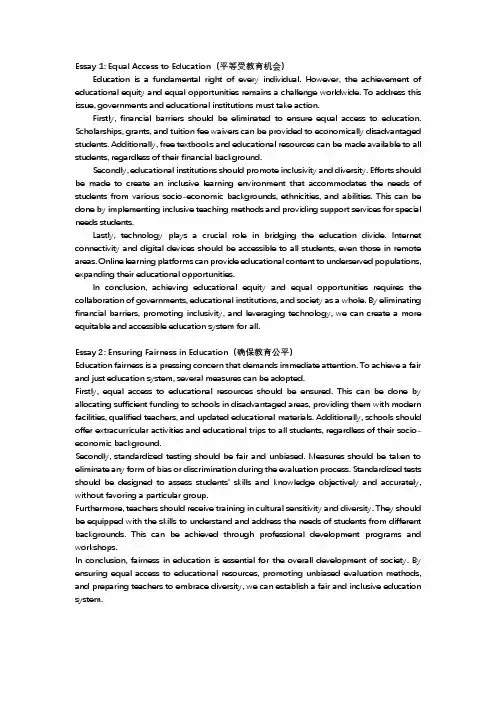
Essay 1: Equal Access to Education(平等受教育机会)Education is a fundamental right of every individual. However, the achievement of educational equity and equal opportunities remains a challenge worldwide. To address this issue, governments and educational institutions must take action.Firstly, financial barriers should be eliminated to ensure equal access to education. Scholarships, grants, and tuition fee waivers can be provided to economically disadvantaged students. Additionally, free textbooks and educational resources can be made available to all students, regardless of their financial background.Secondly, educational institutions should promote inclusivity and diversity. Efforts should be made to create an inclusive learning environment that accommodates the needs of students from various socio-economic backgrounds, ethnicities, and abilities. This can be done by implementing inclusive teaching methods and providing support services for special needs students.Lastly, technology plays a crucial role in bridging the education divide. Internet connectivity and digital devices should be accessible to all students, even those in remote areas. Online learning platforms can provide educational content to underserved populations, expanding their educational opportunities.In conclusion, achieving educational equity and equal opportunities requires the collaboration of governments, educational institutions, and society as a whole. By eliminating financial barriers, promoting inclusivity, and leveraging technology, we can create a more equitable and accessible education system for all.Essay 2: Ensuring Fairness in Education(确保教育公平)Education fairness is a pressing concern that demands immediate attention. To achieve a fair and just education system, several measures can be adopted.Firstly, equal access to educational resources should be ensured. This can be done by allocating sufficient funding to schools in disadvantaged areas, providing them with modern facilities, qualified teachers, and updated educational materials. Additionally, schools should offer extracurricular activities and educational trips to all students, regardless of their socio-economic background.Secondly, standardized testing should be fair and unbiased. Measures should be taken to eliminate any form of bias or discrimination during the evaluation process. Standardized tests should be designed to assess students' skills and knowledge objectively and accurately, without favoring a particular group.Furthermore, teachers should receive training in cultural sensitivity and diversity. They should be equipped with the skills to understand and address the needs of students from different backgrounds. This can be achieved through professional development programs and workshops.In conclusion, fairness in education is essential for the overall development of society. By ensuring equal access to educational resources, promoting unbiased evaluation methods, and preparing teachers to embrace diversity, we can establish a fair and inclusive education system.Essay 3: Breaking Barriers for Educational Equality(打破教育平等的障碍)Educational equality is a fundamental principle that every society should strive to achieve. Breaking barriers and creating an equal playing field is crucial in this regard.Firstly, socio-economic status should not hinder access to quality education. Scholarships and grants should be offered to economically disadvantaged students, enabling them to pursue higher education without financial burdens. Furthermore, vocational training programs can equip individuals with practical skills, enhancing their employment prospects.Secondly, gender disparities in education should be eliminated. Girls' education should be prioritized and encouraged, ensuring equal opportunities for both sexes. Awareness campaigns and community support can help change societal attitudes towards girls' education and challenge traditional gender roles.Moreover, schools should implement inclusive policies to cater to students with disabilities. Specialized facilities, assistive technologies, and trained personnel should be employed to provide an inclusive learning environment. Additionally, awareness programs should be conducted to promote inclusivity and discourage discrimination based on physical or mental disabilities.In conclusion, achieving educational equality requires concerted efforts from governments, communities, and educational institutions. By addressing socio-economic barriers, eliminating gender disparities, and promoting inclusivity for students with disabilities, we can create a society where everyone has an equal opportunity to realize their educational potential.。
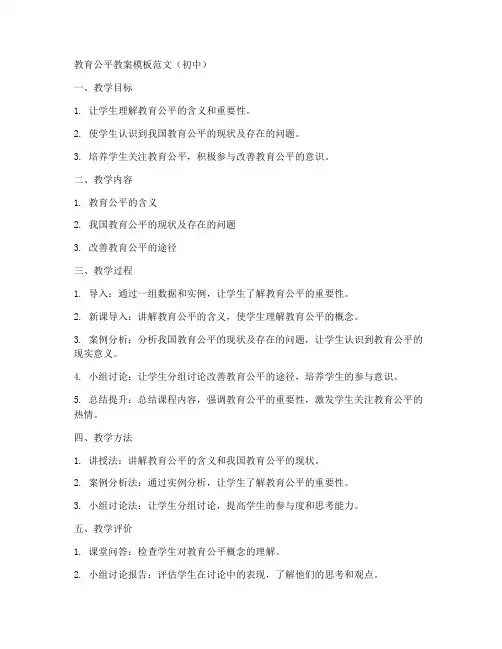
教育公平教案模板范文(初中)一、教学目标1. 让学生理解教育公平的含义和重要性。
2. 使学生认识到我国教育公平的现状及存在的问题。
3. 培养学生关注教育公平,积极参与改善教育公平的意识。
二、教学内容1. 教育公平的含义2. 我国教育公平的现状及存在的问题3. 改善教育公平的途径三、教学过程1. 导入:通过一组数据和实例,让学生了解教育公平的重要性。
2. 新课导入:讲解教育公平的含义,使学生理解教育公平的概念。
3. 案例分析:分析我国教育公平的现状及存在的问题,让学生认识到教育公平的现实意义。
4. 小组讨论:让学生分组讨论改善教育公平的途径,培养学生的参与意识。
5. 总结提升:总结课程内容,强调教育公平的重要性,激发学生关注教育公平的热情。
四、教学方法1. 讲授法:讲解教育公平的含义和我国教育公平的现状。
2. 案例分析法:通过实例分析,让学生了解教育公平的重要性。
3. 小组讨论法:让学生分组讨论,提高学生的参与度和思考能力。
五、教学评价1. 课堂问答:检查学生对教育公平概念的理解。
2. 小组讨论报告:评估学生在讨论中的表现,了解他们的思考和观点。
3. 课后作业:布置相关课题的作业,让学生进一步深入思考教育公平问题。
六、教学资源1. 数据和实例:用于说明教育公平的重要性。
2. 小组讨论指南:为学生提供讨论的方向和话题。
3. 课后作业:相关课题的作业,帮助学生巩固课堂所学。
七、教学步骤1. 导入:通过一组数据和实例,让学生了解教育公平的重要性。
2. 新课导入:讲解教育公平的含义,使学生理解教育公平的概念。
3. 案例分析:分析我国教育公平的现状及存在的问题,让学生认识到教育公平的现实意义。
4. 小组讨论:让学生分组讨论改善教育公平的途径,培养学生的参与意识。
5. 总结提升:总结课程内容,强调教育公平的重要性,激发学生关注教育公平的热情。
八、教学反思本教案旨在让学生了解教育公平的含义、我国教育公平的现状及存在的问题,培养学生关注教育公平的意识。

是否应该废除教育公平辩论辩题正方观点:首先,我们认为应该废除教育公平。
教育公平的概念本身就存在着很多问题。
每个人天生的智力和能力都是不同的,所以要求教育公平实际上是对人的不同能力和天赋的一种忽视和歧视。
正如美国作家马克·吐温曾经说过,“如果你用一条鱼的能力来衡量一只猴子,那么这只猴子一辈子都会觉得自己是个失败者。
”因此,我们认为教育应该根据个人的能力和兴趣来进行个性化的教育,而不是一刀切的要求教育公平。
其次,教育公平的实施也存在着很多困难和问题。
在现实社会中,很难做到真正的教育公平。
因为不同地区、不同家庭的条件和资源都是不同的,所以要求教育公平实际上是一种不切实际的幻想。
正如中国古代思想家孔子曾经说过,“同学不同,不可使同学也。
”因此,我们认为教育公平的要求是不现实的,应该废除。
最后,教育公平的实施也会对教育质量造成负面影响。
为了实现教育公平,很多学校和教育机构会采取一刀切的方式,忽视了学生个体的差异和需求。
这样一来,教育质量就会大大降低。
正如美国教育家约翰·杜威曾经说过,“教育不是灌输,而是点燃一把火。
”我们应该注重个性化教育,而不是一味追求教育公平。
反方观点:我们认为不应该废除教育公平。
教育公平是现代社会的基本原则之一,它体现了社会的公正和公平。
正如美国总统约翰·肯尼迪曾经说过,“公平是人类的共同理想。
”教育公平的实施可以帮助每个人都有机会接受教育,实现自己的梦想,这是社会进步的基石。
其次,教育公平的实施可以帮助弱势群体获得更多的机会。
在现实社会中,很多家庭和地区的资源不足,如果没有教育公平的要求,那么这些弱势群体将永远无法获得良好的教育资源。
正如南非总统曼德拉曾经说过,“教育是最强大的武器,用来改变世界。
”我们应该坚持教育公平的要求,帮助每个人都有机会获得良好的教育。
最后,教育公平的实施可以促进社会的稳定和发展。
如果社会中存在着教育不公平的现象,那么社会的不稳定就会加剧。
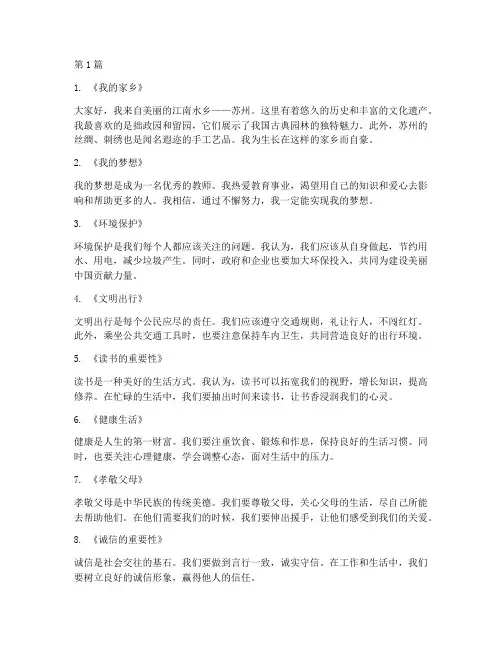
第1篇1. 《我的家乡》大家好,我来自美丽的江南水乡——苏州。
这里有着悠久的历史和丰富的文化遗产。
我最喜欢的是拙政园和留园,它们展示了我国古典园林的独特魅力。
此外,苏州的丝绸、刺绣也是闻名遐迩的手工艺品。
我为生长在这样的家乡而自豪。
2. 《我的梦想》我的梦想是成为一名优秀的教师。
我热爱教育事业,渴望用自己的知识和爱心去影响和帮助更多的人。
我相信,通过不懈努力,我一定能实现我的梦想。
3. 《环境保护》环境保护是我们每个人都应该关注的问题。
我认为,我们应该从自身做起,节约用水、用电,减少垃圾产生。
同时,政府和企业也要加大环保投入,共同为建设美丽中国贡献力量。
4. 《文明出行》文明出行是每个公民应尽的责任。
我们应该遵守交通规则,礼让行人,不闯红灯。
此外,乘坐公共交通工具时,也要注意保持车内卫生,共同营造良好的出行环境。
5. 《读书的重要性》读书是一种美好的生活方式。
我认为,读书可以拓宽我们的视野,增长知识,提高修养。
在忙碌的生活中,我们要抽出时间来读书,让书香浸润我们的心灵。
6. 《健康生活》健康是人生的第一财富。
我们要注重饮食、锻炼和作息,保持良好的生活习惯。
同时,也要关注心理健康,学会调整心态,面对生活中的压力。
7. 《孝敬父母》孝敬父母是中华民族的传统美德。
我们要尊敬父母,关心父母的生活,尽自己所能去帮助他们。
在他们需要我们的时候,我们要伸出援手,让他们感受到我们的关爱。
8. 《诚信的重要性》诚信是社会交往的基石。
我们要做到言行一致,诚实守信。
在工作和生活中,我们要树立良好的诚信形象,赢得他人的信任。
9. 《团队精神》团队精神是一个集体成功的关键。
我们要学会团结协作,共同为实现目标而努力。
在团队中,每个人都要发挥自己的优势,为集体贡献力量。
10. 《科技创新》科技创新是推动社会发展的重要力量。
我们要关注科技创新,努力学习科学知识,为国家的科技进步贡献自己的力量。
11. 《志愿服务》志愿服务是社会文明进步的体现。
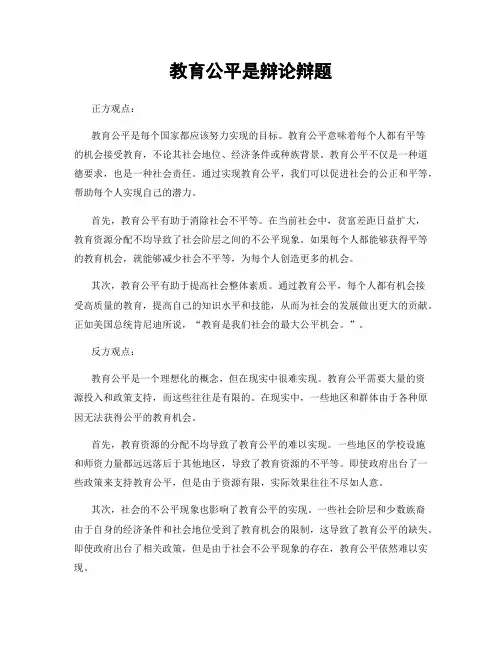
教育公平是辩论辩题正方观点:教育公平是每个国家都应该努力实现的目标。
教育公平意味着每个人都有平等的机会接受教育,不论其社会地位、经济条件或种族背景。
教育公平不仅是一种道德要求,也是一种社会责任。
通过实现教育公平,我们可以促进社会的公正和平等,帮助每个人实现自己的潜力。
首先,教育公平有助于消除社会不平等。
在当前社会中,贫富差距日益扩大,教育资源分配不均导致了社会阶层之间的不公平现象。
如果每个人都能够获得平等的教育机会,就能够减少社会不平等,为每个人创造更多的机会。
其次,教育公平有助于提高社会整体素质。
通过教育公平,每个人都有机会接受高质量的教育,提高自己的知识水平和技能,从而为社会的发展做出更大的贡献。
正如美国总统肯尼迪所说,“教育是我们社会的最大公平机会。
”。
反方观点:教育公平是一个理想化的概念,但在现实中很难实现。
教育公平需要大量的资源投入和政策支持,而这些往往是有限的。
在现实中,一些地区和群体由于各种原因无法获得公平的教育机会。
首先,教育资源的分配不均导致了教育公平的难以实现。
一些地区的学校设施和师资力量都远远落后于其他地区,导致了教育资源的不平等。
即使政府出台了一些政策来支持教育公平,但是由于资源有限,实际效果往往不尽如人意。
其次,社会的不公平现象也影响了教育公平的实现。
一些社会阶层和少数族裔由于自身的经济条件和社会地位受到了教育机会的限制,这导致了教育公平的缺失。
即使政府出台了相关政策,但是由于社会不公平现象的存在,教育公平依然难以实现。
结论:从正方和反方的角度来看,教育公平是一个复杂的问题。
虽然教育公平是一个理想化的目标,但是在现实中往往难以实现。
我们需要更多的资源投入和政策支持,才能够实现教育公平。
同时,我们也需要关注社会的不公平现象,从根本上解决教育公平的问题。
只有这样,我们才能够让每个人都有平等的机会接受教育,实现自己的梦想。


高中英语作文《实现教育公平的举措》Title: Measures to Achieve Educational EquityEducational equity is a pressing issue that demands immediate attention and substantial efforts from society.It is the principle that every individual should have access to quality education regardless of their socioeconomic status, race, gender, or any other factors.To achieve educational equity, various measures need to be implemented.First and foremost, it is crucial to provide equal access to education for all children.This means ensuring that every child, regardless of their family's income or background, has the opportunity to attend well-funded and high-quality ernments should allocate sufficient funds for education and prioritize the needs of underprivileged areas.Additionally, efforts should be made to reduce achievement gaps among different groups of students.This can be achieved by implementing targeted interventions and support programs for students who are at a disadvantage.Moreover, it is essential to address the issue of teacher diversity.Currently, there is a significant lack of representation among teachers, particularly in schools serving minority communities.To tackle this problem, initiatives should be launched to recruit more teachers from diverse backgrounds.Furthermore, ongoing professional development and cultural sensitivity training should be provided to educators toensure that they can create inclusive and supportive learning environments for all students.Another crucial aspect of achieving educational equity is to eliminate the impact of socioeconomic status on students' educational outcomes.This can be done by implementing need-based financial aid and scholarships to ensure that students from low-income families can afford the necessary educational resources, such as textbooks and extracurricular activities.Additionally, efforts should be made to reduce the burden of student debt for higher education students, as the cost of attending college can be a significant barrier to educational equity.Finally, it is important to promote a culture of equity and inclusion in education.This involves fostering an environment where all students feel valued, respected, and supported.Schools should implement policies that promote diversity and inclusion, and educators should encourage students to embrace diversity and respect each other's differences.In conclusion, achieving educational equity is a multifaceted challenge that requires a comprehensive approach.By implementing these measures, we can work towards creating a more equitable and just educational system that provides equal opportunities for all students to succeed.It is our responsibility as a society to ensure that every child has access to quality education, regardless of their background or circumstances.。

教育公平辩论辩题正方,公平辩论辩题对。
首先,我想强调的是公平辩论的重要性。
公平辩论是一种尊重对手、尊重事实和逻辑的辩论方式,它能够促进双方的思维和表达能力,有利于培养辩手的辩论素养和逻辑思维能力。
在公平辩论中,每个人都有机会表达自己的观点,不会因为背景或地位的不同而受到歧视,这有利于促进社会的公平和和谐。
其次,公平辩论可以帮助人们更好地理解和接受不同的观点。
在辩论中,我们需要尊重对手的观点,认真倾听对方的论证,这有助于我们更全面地了解问题,从而做出更准确的判断。
正如美国总统林肯曾经说过的,“我不喜欢这个人的观点,但我愿意为他的权利奋斗,因为我知道,如果我不为他的权利奋斗,那么在某一天,我也可能失去我的权利。
”。
最后,公平辩论可以促进社会的进步和发展。
在公平辩论中,人们可以充分交流和碰撞思想,这有助于激发创新和改革的动力。
正如英国哲学家弗朗西斯·培根所说,“辩论是真理的试金石。
”只有在公平的辩论中,真理才能得到充分的展现,社会才能不断向前发展。
综上所述,公平辩论对是非常重要的。
它有利于培养辩手的辩论素养和逻辑思维能力,有助于人们更好地理解和接受不同的观点,同时也有助于促进社会的进步和发展。
因此,我们应该积极倡导和支持公平辩论,让它成为我们社会交流和思考的重要方式。
反方,公平辩论辩题对。
尊敬的各位评委,我作为反方辩手,我要强调的是公平辩论并不是适合所有情况的。
首先,公平辩论可能会导致一些不必要的争论和冲突。
在辩论中,双方可能会因为对立的观点而产生矛盾和摩擦,这有可能会影响双方的关系,甚至导致更严重的后果。
其次,公平辩论可能会给一些不负责任的言论提供平台。
在辩论中,有些人可能会利用言辞和逻辑的漏洞来误导和欺骗他人,这有可能会对社会造成不良影响。
正如英国哲学家罗素所说,“不要让无知者误导你,也不要让有意欺骗者愚弄你。
”。
最后,公平辩论可能会给一些不利于社会和谐的观点提供机会。
在辩论中,有些人可能会利用言辞和逻辑来宣扬歧视、仇恨和暴力的观点,这有可能会对社会的和谐和稳定造成威胁。

《教育公平性评估标准》解读(详细版)《教育公平性评估标准》解读(详细版)1. 引言教育公平性是当前教育领域的重要议题之一,受到全球各国的广泛关注。
为了更好地理解和衡量教育公平性,我们制定了一套《教育公平性评估标准》。
本文档将详细解读这套评估标准,帮助读者深入理解其内涵和应用方法。
2. 《教育公平性评估标准》概述《教育公平性评估标准》包含以下五个维度,每个维度下又有具体的评估指标。
2.1 入学公平性入学公平性主要评估学生入学机会的均等性,包括以下指标:- 入学机会均等性:评估学生是否能公平地获得入学机会,不受家庭背景、地域、性别等因素的影响。
- 招生政策透明度:评估学校招生政策的公开程度,确保家长和学生能够充分了解招生标准和流程。
2.2 资源分配公平性资源分配公平性主要评估教育资源的合理分配情况,包括以下指标:- 教育资源均衡分配:评估教育经费、师资、设施等资源的分配是否均衡,确保所有学校和地区都能获得合理的教育资源。
- 特殊教育资源投入:评估针对特殊需求学生的教育资源投入情况,确保他们能够获得适当的教育支持。
2.3 教育过程公平性教育过程公平性主要评估教育过程中学生权益的保障情况,包括以下指标:- 师生互动质量:评估师生之间的互动是否积极、平等,确保学生能够得到充分的关注和指导。
- 课程设置公平性:评估学校课程设置是否满足不同学生的需求,确保学生能够获得多元化的教育体验。
2.4 教育成果公平性教育成果公平性主要评估学生教育成果的均等性,包括以下指标:- 学业成绩均等性:评估学生学业成绩是否存在显著的差距,确保所有学生都能获得公平的教育成果。
- 升学机会均等性:评估学生升学机会是否存在显著的差距,确保所有学生都能获得公平的升学机会。
2.5 教育政策公平性教育政策公平性主要评估教育政策对学生权益的保障情况,包括以下指标:- 教育政策倾斜度:评估教育政策是否对弱势群体给予足够的关注和支持,确保他们能够获得公平的教育机会。
教育公平辩论辩题正方辩手:首先,我要强调公平辩论的重要性。
公平辩论是一种让不同观点和声音得到公正对待的辩论方式,它能够促进思想交流,激发智慧火花,有助于人们更好地理解和接纳不同的观点。
公平辩论不仅是一种辩论方式,更是一种民主精神和社会进步的体现。
其次,公平辩论能够帮助人们更好地理解和认识世界。
在辩论中,不同的观点和论据会被充分呈现,人们可以通过辩论了解到更多的信息和观点,从而更全面地认识问题。
正如英国哲学家约翰·斯图尔特·密尔所说,“在没有公平辩论的社会中,真理将会变得苍白无力。
”公平辩论能够帮助人们找到更接近真理的观点,促进社会的进步和发展。
最后,公平辩论有助于培养人们的辩论能力和思维能力。
在辩论中,人们需要理性地分析问题,寻找论据,提出合理的观点,这有助于培养人们的逻辑思维能力和辩论技巧。
正如美国总统林肯所说,“辩论是一种民主社会中不可或缺的能力,它能够培养人们的思辨和分析能力,使人们更好地理解和解决问题。
”。
综上所述,公平辩论对于促进社会进步、增强人们的辩论能力和思维能力都具有重要意义,我们应该积极倡导和支持公平辩论。
反方辩手:我认为公平辩论并不是一种完全可取的辩论方式。
首先,公平辩论可能会导致一些不负责任的言论得到放大和传播,从而对社会造成不良影响。
在辩论中,一些不负责任的观点和论据可能会被放大,引起社会的恐慌和不安,这并不符合社会的利益。
正如英国哲学家伯特兰·罗素所说,“在公平辩论中,不负责任的言论可能会对社会造成不良影响,我们应该有所节制。
”。
其次,公平辩论可能会导致一些极端观点的传播和强化。
在辩论中,一些极端观点可能会被放大和强化,导致社会的分裂和对立。
正如美国历史学家亨利·亚当斯所说,“在公平辩论中,极端观点可能会得到放大和强化,导致社会的分裂和对立,这并不符合社会的和谐发展。
”。
最后,公平辩论可能会导致一些不当的观点和论据得到认可和传播。
教育公平演讲稿
各位老师,亲爱的同学们:
大家好!今天我想和大家谈一谈教育公平这个话题。
教育公平,是一个关乎每
个人的命运和未来的重要问题。
教育公平,意味着每个人都有平等的机会接受教育,不论贫富、不论地域、不论性别、不论种族,每个人都有权利获得优质的教育资源。
然而,现实中我们却发现教育公平并不普遍存在。
在一些地区,由于资源分配
不均,导致了教育资源的不公平现象。
一些地方的学校设施简陋,师资力量匮乏,学生们的学习环境和条件远远落后于其他地区。
而在一些家庭,由于经济条件的限制,孩子们无法获得良好的教育资源,甚至无法接受基本的教育。
教育公平的缺失,不仅影响了个人的成长和发展,也影响了整个社会的进步和
发展。
因为教育公平的缺失,导致了社会资源的浪费,也导致了社会的不公平现象。
在一个没有教育公平的社会里,富人的孩子可以接受最好的教育资源,而贫困家庭的孩子却只能被束缚在贫困的环境中,这种不公平现象会导致社会的不稳定和不公正。
因此,我们每个人都应该为教育公平负起责任。
作为学生,我们应该珍惜学习
的机会,努力学习,不断提高自己,为自己的未来打下坚实的基础。
作为家长,我们应该关注孩子的教育问题,给予他们更多的关爱和支持,让他们能够享受到优质的教育资源。
作为社会的一员,我们更应该呼吁社会各界关注教育公平的问题,促进教育资源的均衡分配,让每个孩子都有机会接受优质的教育。
教育公平,是每个人都应该关注的问题,也是我们共同努力的方向。
让我们携
起手来,共同为教育公平而努力,让每个孩子都能够享受到公平的教育资源,让社会更加和谐、稳定、公正!
谢谢大家!。
教师资格证笔试知识点一、知识概述《综合素质中的作文知识点》①基本定义:教师资格证笔试综合素质中的作文就是根据给定的材料或者话题,按照一定的要求写出一篇文章,要求文章观点明确、逻辑清晰、语言通顺等。
②重要程度:作文在综合素质这科里占比较大,说实话,要是作文写砸了,这一科想过就有点悬。
它能很好地考察考生的综合素养,包括文字表达、思维能力、文化知识储备等。
③前置知识:需要有基本的文字组织能力,对一些常见的教育理念、社会现象要有一定的了解,还得知道些基本的文章结构知识,像总分总之类的。
④应用价值:在实际教学工作中,教师经常要写教学计划、总结、教案等,都需要良好的写作能力。
而且良好的文字表达有助于清晰地向学生传授知识,传递正确的价值观。
二、知识体系①知识图谱:作文是综合素质中的一个重要模块,在整个学科中占重要的分值分量。
②关联知识:它和教育知识、文化素养等知识都有关系。
比如教育知识能提供一些教育观点用于作文素材,文化素养则可以让文章内容更丰富。
③重难点分析:- 掌握难度:难点在于准确把握题意,有时候给定的材料可能比较隐晦。
还得在规定时间内,迅速组织思路和论据,挺考验人的,我第一次写的时候就有点懵。
- 关键点:立意要准确并且有深度,文章结构要合理,论述要有条理。
④考点分析:- 在考试中的重要性:超级重要,几乎是综合素质能不能及格的一个关键因素。
- 考查方式:一般是材料作文,给个材料或者话题让考生自由发挥,但肯定是和教育相关或者社会主流价值观相关的话题比较多。
三、详细讲解【文学文化类】①背景介绍:这些作文主题往往都是跟当下的教育改革、文化传承、社会正能量等时代背景相关的。
比如现在强调素质教育,那作文可能就会让你谈谈对素质教育在学校推行的看法。
②内容赏析:要是以教育公平为主题,那我们可以从不同角度赏析这个主题内容。
从社会层面看,教育公平是社会公平正义的基石;从个人成长角度,每个孩子都应该有平等受教育的机会去改变命运。
教育公平问题演讲稿
尊敬的各位领导、老师和同学们:
大家好!今天我想和大家谈谈教育公平这一重要的话题。
教育公平,是指每个人都有平等的接受教育的权利和机会。
然而,在现实生活中,我们却发现教育资源分配不均,导致了教育公平的问题。
这种不公平表现在各个方面,有的学校设施齐全,教学资源丰富,而有的学校却条件艰苦,师资力量薄弱;有的家庭能够给孩子提供优质的教育资源,而有的家庭却因为经济条件的限制而无法做到。
这种不公平使得一些孩子从出生起就处于劣势地位,无法享受到优质的教育资源,这是非常不公平的。
教育公平的问题不仅仅是一种道德上的问题,更是一种社会发展的障碍。
因为
教育公平的缺失导致了社会资源的浪费,也使得一些有潜力的人才无法得到充分的发展。
而且,教育公平的缺失也会导致社会的不稳定和不公平,因为教育是社会流动的重要途径,如果教育资源不公平分配,就会导致社会的不公平和不稳定。
那么,我们应该怎么做呢?首先,我们应该加大对教育的投入,特别是对贫困
地区和贫困家庭的教育投入。
其次,我们应该建立起一套完善的教育资源分配机制,确保每个孩子都能够享受到优质的教育资源。
最后,我们更应该注重教育的个性化和多元化,让每个孩子都能够找到适合自己的教育方式和途径。
教育公平是我们每个人都应该关心的问题,因为每个人都有权利享受到优质的
教育资源。
让我们共同努力,为教育公平而奋斗!
谢谢大家!。
两会热点——教育公平
查汗采开乡中心学校备课人:张鹏文
教学目标:
1、让学生了解什么是教育公平和教育不公平。
2、让学生了解教育不公平的主要体现及如何促进教育公平。
3、让学生知道教育是最基本的权利和义务。
教学准备:PPT
课时安排:三分钟
教学过程:
一、激趣入境
问题引入:什么是教育公平?
二、教授新课
1、一起讨论教育不公平的体现
2、如何促进教育公平?:
教育不公平与政策、制度缺失或不健全有关, 可以通过政、策修补和制度创新来解决, 努力为教育公平提供政策保障。
鉴于我国社会主义初级阶段的国情和建设和谐社会的需要, 以及教育不公平现象的存在, 必须构建教育公平机制。
加大对国家教育资源分配、城乡分配、区域分配格局的调整力度, 把教育资源公平地投放于社会, 是贯彻落实中央“三农”政策的具体体现。
在当前优质教育资源稀缺的情况下, 要在更大的范围内和程度上实现教育公平, 满足社会公众的合理需求, 不仅需要一定的理论导向和科学依据, 更需要一套有效的模式。
三、总结
当今社会, 教育国际化、现代化、民主化等特征日益显著, 教育公平已成为当代教育的主题和基本价值。
实现教育公平是复杂、曲折的历史实践过程, 它涉及到教育资源配置, 教育政策、规则制定, 教育管理等过程。
这需要教育行政部门、学校和社会力量的通力协作, 确保“教育权利平等”和“教育机会平等”, 促进社会公平, 促进和谐社会建设, 实现人的全面发展。
《教育哲学》习题与答案(解答仅供参考)一、名词解释1. 教育哲学:教育哲学是研究教育领域基本问题的学科,它探讨教育的本质、目的、价值、方法和过程等根本性问题,为教育实践提供理论基础和指导原则。
2. 教育目的论:教育目的论是指关于教育最终目标或理想状态的学说体系,涉及教育应培养什么样的人以及如何培养等问题。
不同的教育目的论反映了不同社会文化背景下对个体发展和社会进步的不同期待和要求。
3. 教育公平:教育公平是指每个人不论其性别、种族、民族、经济状况、家庭背景等因素,都有平等接受教育的机会,并在教育资源分配、教育过程及教育结果上得到公正对待。
4. 教育本质观:教育本质观是对教育内在属性和特性的哲学思考,通常包括对教育目的、教育内容、教育方式及其与个体、社会、文化关系等方面的根本性认识和把握。
5. 自我实现教育理论:自我实现教育理论源于马斯洛的人本主义心理学,强调尊重学生的个性差异和潜能开发,主张通过满足学生自我实现需求的方式促进其全面发展,提倡以学生为中心的教学模式和非指导性教学法。
二、填空题1. _________是教育哲学的基本问题之一,它关注教育活动应当培养具有何种品质和能力的人。
(答案:教育目的)2. 孔子提出的“有教无类”体现了_________的教育理念。
(答案:教育公平)3. _________认为教育的主要任务是帮助每个学生发现和发展自己的潜能,实现自我价值。
(答案:人本主义教育哲学)4. 在教育过程中,_________是指教师根据学生的特点和需求,有针对性地选择和设计教学策略和方法。
(答案:因材施教)5. _________从存在主义视角出发,强调个人自由与责任,主张教育应培养独立自主、能批判反思的人。
(答案:存在主义教育哲学)三、单项选择题1. 下列哪位教育家提出了“教育即生活,学校即社会”的观点?(C)A. 康德B. 赫尔巴特C. 杜威D. 卢梭2. 关于教育公平的理解,下列说法错误的是:(D)A. 教育公平既包括机会公平也包括结果公平B. 教育公平涉及教育资源配置的合理化C. 教育公平需要关注弱势群体的教育权益D. 教育公平意味着所有学生必须获得相同的教育资源和成果3. 以下哪种教育观念强调知识的主观建构,而非被动接受?(B)A. 知识传授观B. 建构主义观C. 实用主义观D. 理性主义观4. 提出“教育的任务在于引导儿童自然发展”的教育家是:(D)A. 夸美纽斯B. 赫尔巴特C. 斯宾塞D. 卢梭5. 下列哪一种教育哲学流派特别重视道德教育和个人品性的培养?(A)A. 人文主义教育哲学B. 存在主义教育哲学C. 后现代主义教育哲学D. 技术理性主义教育哲学四、多项选择题1. 下列哪些属于教育哲学的研究范畴?(ABCD)A. 教育目的与价值取向B. 教育制度与政策C. 教育伦理与道德D. 教育改革与发展路径E. 教育经济效益分析2. 下列哪些教育哲学流派倡导以学生为中心的教育思想?(AC)A. 人本主义教育哲学B. 理性主义教育哲学C. 存在主义教育哲学D. 实用主义教育哲学E. 后现代主义教育哲学3. 教育公平的内涵可以涵盖以下几个方面?(ABCD)A. 机会均等B. 资源配置公平C. 过程公平D. 结果公平E. 所有学生获得完全相同的发展水平4. 以下哪些教育家的观点有助于理解教育的本质?(ABC)A. 杜威的“教育即生活”B. 卢梭的“回归自然”C. 康德的“人是目的本身”D. 赫尔巴特的“形式阶段论”E. 夸美纽斯的“泛智教育”5. 教育哲学对教育实践的影响体现在:(ABCD)A. 指导教育改革的方向B. 影响教育教学的理念和方法C. 审视和评价教育政策的价值合理性D. 培养教育工作者的教育信念和价值观E. 直接提高教育质量和效率五、判断题1. 教育哲学是一门纯理论性学科,与实际教育工作无关。